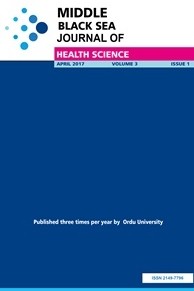Tabanid Infestation of Cattle and Its Implications for Public Health
Female tabanids are important for public health and veterinary. As bloodsucking pests and vectors of disease agents they give harm to humans. They serve as vectors of such agents as Dermatobia hominis, Loa loa, Tularemi, Bacillus anthrasis, Trypanosoma evansi, Coxiella burunetti, Dirofilaria repens. Cattlemen living here raise their cattle on vineyards and orchards, olive groves, almond groves or uncultivated lands. These animals are tied with a halter and a long strap fixed to the ground. The aim of this study was to investigate tabanids infestation in Datça, Muğla. The study was conducted from April 2018 in Datça district. In this paper the Holstein hybrid cattle, old male cattle, tabanids sucking its blood as well as the diseases caused by tabanids are the subject of the study. The skin integrity on the lateral aspect of distal metacarpus in the left hind limb of the cattle was impaired. Hundreds of tabanids lacerated the skin, and sucked blood, causing hemorrhage in the epidermis. This study revealed that tabanids constitute a threat to animal and public health. We highlight the importance of effective prevention and control measures during periods in which these flies are active. More comprehensive epidemiological studies should be undertaken and national control programs are required to keep the tabanids infestation under control.
Keywords:
Cattle, tabanids public health,
___
- Anonymous, 2018. http://www.muglakulturturizm.gov.tr/Eklenti/57017,2017-milkapi-aralikpdf.pdf
- Barnard DR. Control of fly-borne diseases. Pesticide Outlook 2003; 14: 222 – 228.
- Davis SG. Seasonal and geographical distribution of Tabanus abactor Philip and associated species in the Texas Rolling Plains. A Thesis in Entomology. Texas Tech University. Lubbock, 1979.
- Girişkin AO, Tabanidler Vektör lükleri ve Mücadelesi Özbel Y. editör. Vektör Artropodlar ve Mücadelesi, İzmir, Turkey Parazitoloji Derneği Yayın No:25, 2017.
- Hornok S, Elek V, de la Fuente J, Naranjo V, Farkas R, Majoros G, Földvári G. First serological and molecular evidence on the endemicity of Anaplasma ovis and A-marginale in Hungary. Vet Microbiol 2007; 122:316–322.
- Lehane MJ. The biology of blood-sucking in insects, 2nd edn. Cambridge University Press, Cambridge, 2005.
- Tashiro H, Schwardt, HH. "Biological Studies of Horse Flies in New York." J. Econ. Entomol.46:813-22, 1953.
- Taylor PD, Smith SM. Activities and physiological states of male andfemale Tabanus sackeni. Med Vet Entomol 1989; 3: 203–12.
- Yücel ŞY. Tabanidae. Karaer KZ, Dumanlı N, editörler. Arthropodoloji, Ankara: Medisan Yayınevi; 2015. sf. 203-214.
- Wall R, Shearer D. Veterinary Entomology. UK: Chapman and Hall, 1997.
- Yayın Aralığı: Yılda 4 Sayı
- Başlangıç: 2015
- Yayıncı: Ordu Üniversitesi
Sayıdaki Diğer Makaleler
Fehminaz TEMEL, Songül ACAR VAİZOĞLU
Gürkan ALTUNTAŞ, Ali AYGÜN, Murat Mümin YAZICI, Melih İMAMOĞLU, Selim YURTSEVER, Özlem BİLİR
Ahmet YILMAZ, Önder AKKAŞ, Esin GÜVEN, Hakan AYDIN, Hakan USLU
